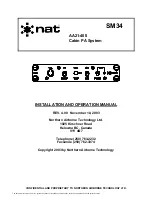
PRIMUS
r
1000 Integrated Avionics System
A28--1146--112--00
Modes of Operation
8-6
When reaching the lateral beam sensor (LBS) trip point, as shown in
figure 8--5, the system automatically drops the heading select mode
and switches to the VOR capture phase. The following is displayed on
the PFD (see figure 8--6):
D
The white VOR annunciator extinguishes
D
The green HDG annunciator extinguishes
D
A green VOR is annunciated and is enclosed in a white box for 8
seconds to emphasize the capture phase of operation.
The IAC generates the proper roll command to bank the aircraft to
capture and track the selected VOR radial.
When the course select pointer is set on the PFD using the course
(CRS) knob on the GC, the course select error signal is established.
This signal represents the difference between the actual aircraft
heading and the desired aircraft course. The course error signal is then
sent from the SG function to the flight control function in the IAC.
The radio signal is routed from the navigation receiver to the IAC. The
IAC lateral gain programs the signal in its flight control function.
The lateral gain programming is performed as a function of distance
measuring equipment (DME), distance to the station (if available), and
true airspeed (TAS). Gain programming adjusts for the aircraft either
coming toward or moving away from the VOR station.
NOTE:
Avoid operating in DME hold during VOR capture and
tracking operation if possible. When in DME hold, the
computer cannot use DME distance for gain programming.
VOR Navigation Mode Capture Plan View
Figure 8--5
When flying a VOR intercept, the optimum intercept angle is 45
_
or less.





































